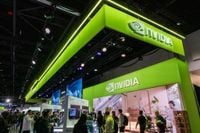Nvidia's shares plummeted in after-hours trading following the announcement that the US government has imposed new export restrictions on its H20 AI chips to China. The decision, announced on April 16, 2025, is expected to cost the chip designer approximately $5.5 billion, raising concerns across the semiconductor industry.
The restrictions are part of a broader strategy by the US to curb China's access to advanced technology amid escalating tensions over artificial intelligence supremacy. The Biden administration's regulations require Nvidia to obtain a special license to sell its H20 chips, which were designed specifically for the Chinese market. This new requirement marks a significant tightening of export controls since previous limitations were first introduced in October 2022.
In an official filing, Nvidia stated that the new rules were implemented to mitigate the risk that its products might be “used in, or diverted to, a supercomputer in China.” As a result, the company anticipates reporting substantial charges in the financial quarter ending April 27, 2025, due to existing stocks of H20 chips and sales commitments. The announcement has already triggered a selloff across the semiconductor sector, with Nvidia's shares dropping about 6% in after-hours trading.
Advanced Micro Devices (AMD), a key competitor in the AI market, also felt the impact, with shares falling 7% as investors reacted to the news. The ramifications were felt globally, with South Korean semiconductor giants like Samsung Electronics and SK Hynix experiencing declines of up to 3% in overnight trading. In Europe, shares of ASML, a Dutch company that manufactures lithography machines essential for chip production, dropped 5% following comments from its CEO, Christophe Fouquet, who noted that the recent tariff announcements have heightened uncertainty in the macroeconomic environment.
As the situation unfolds, Nvidia's future in the Chinese market looks increasingly precarious. The company has enjoyed a meteoric rise in recent years, with its stock surging over 1,400% since 2020, making it one of the most valuable companies in the US. However, the new restrictions threaten to undermine those gains. The company had previously announced plans to invest up to $500 billion in AI infrastructure in the US over the next four years, emphasizing its commitment to bolstering domestic manufacturing.
The US government has been proactive in addressing national security concerns related to the semiconductor supply chain. This week, the Department of Commerce initiated an investigation into the impact of chip and pharmaceutical imports on American national security. The US relies heavily on chips manufactured overseas, particularly from Taiwan, which has been a focal point of trade tensions. Recently, former President Trump imposed a 32% tariff on Taiwanese products, although this tariff was suspended along with many of his reciprocal tariffs last week.
As the US and China continue to vie for leadership in AI technology, the semiconductor industry is caught in the crossfire. While the chip sector has so far been exempt from the 10% tariffs that took effect on April 5, 2025, Trump hinted at the possibility of imposing new levies on imported semiconductors in the coming days. This uncertainty has left investors and industry leaders on edge, as they navigate a rapidly changing landscape.
Nvidia's predicament highlights the delicate balance between national security and economic interests. As the US seeks to maintain its technological edge, companies like Nvidia must adapt to the evolving regulatory environment while striving to meet the demands of a global market. The consequences of these export restrictions could have lasting effects on the semiconductor industry and the broader tech landscape.
In summary, Nvidia's recent challenges underscore the complexities of international trade and technology competition. As the US government continues to impose restrictions aimed at curbing China's access to advanced technology, companies like Nvidia will need to find innovative ways to navigate these hurdles while remaining competitive in a rapidly changing industry.


